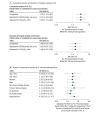Association of Burden of Atrial Fibrillation With Risk of Ischemic Stroke in Adults With Paroxysmal Atrial Fibrillation: The KP-RHYTHM Study
- PMID: 29799942
- PMCID: PMC6145663
- DOI: 10.1001/jamacardio.2018.1176
Association of Burden of Atrial Fibrillation With Risk of Ischemic Stroke in Adults With Paroxysmal Atrial Fibrillation: The KP-RHYTHM Study
Abstract
Importance: Atrial fibrillation is a potent risk factor for stroke, but whether the burden of atrial fibrillation in patients with paroxysmal atrial fibrillation independently influences the risk of thromboembolism remains controversial.
Objective: To determine if the burden of atrial fibrillation characterized using noninvasive, continuous ambulatory monitoring is associated with the risk of ischemic stroke or arterial thromboembolism in adults with paroxysmal atrial fibrillation.
Design, setting, and participants: This retrospective cohort study conducted from October 2011 and October 2016 at 2 large integrated health care delivery systems used an extended continuous cardiac monitoring system to identify adults who were found to have paroxysmal atrial fibrillation on 14-day continuous ambulatory electrocardiographic monitoring.
Exposures: The burden of atrial fibrillation was defined as the percentage of analyzable wear time in atrial fibrillation or flutter during the up to 14-day monitoring period.
Main outcomes and measures: Ischemic stroke and other arterial thromboembolic events occurring while patients were not taking anticoagulation were identified through November 2016 using electronic medical records and were validated by manual review. We evaluated the association of the burden of atrial fibrillation with thromboembolism while not taking anticoagulation after adjusting for the Anticoagulation and Risk Factors in Atrial Fibrillation (ATRIA) or CHA2DS2-VASc stroke risk scores.
Results: Among 1965 adults with paroxysmal atrial fibrillation, the mean (SD) age was 69 (11.8) years, 880 (45%) were women, 496 (25%) were persons of color, the median ATRIA stroke risk score was 4 (interquartile range [IQR], 2-7), and the median CHA2DS2-VASc score was 3 (IQR, 1-4). The median burden of atrial fibrillation was 4.4% (IQR ,1.1%-17.23%). Patients with a higher burden of atrial fibrillation were less likely to be women or of Hispanic ethnicity, but had more prior cardioversion attempts compared with those who had a lower burden. After adjusting for either ATRIA or CHA2DS2-VASc stroke risk scores, the highest tertile of atrial fibrillation burden (≥11.4%) was associated with a more than 3-fold higher adjusted rate of thromboembolism while not taking anticoagulants (adjusted hazard ratios, 3.13 [95% CI, 1.50-6.56] and 3.16 [95% CI, 1.51-6.62], respectively) compared with the combined lower 2 tertiles of atrial fibrillation burden. Results were consistent across demographic and clinical subgroups.
Conclusions and relevance: A greater burden of atrial fibrillation is associated with a higher risk of ischemic stroke independent of known stroke risk factors in adults with paroxysmal atrial fibrillation.
Conflict of interest statement
Figures




Comment in
-
When Low-Risk Atrial Fibrillation Is Not So Low Risk: Beast of Burden.JAMA Cardiol. 2018 Jul 1;3(7):558-560. doi: 10.1001/jamacardio.2018.1205. JAMA Cardiol. 2018. PMID: 29799958 No abstract available.
References
-
- Go AS, Hylek EM, Phillips KA, et al. . Prevalence of diagnosed atrial fibrillation in adults: national implications for rhythm management and stroke prevention: the AnTicoagulation and Risk Factors in Atrial Fibrillation (ATRIA) study. JAMA. 2001;285(18):2370-2375. - PubMed
-
- Miyasaka Y, Barnes ME, Gersh BJ, et al. . Secular trends in incidence of atrial fibrillation in Olmsted County, Minnesota, 1980 to 2000, and implications on the projections for future prevalence. Circulation. 2006;114(2):119-125. - PubMed
-
- Colilla S, Crow A, Petkun W, Singer DE, Simon T, Liu X. Estimates of current and future incidence and prevalence of atrial fibrillation in the US adult population. Am J Cardiol. 2013;112(8):1142-1147. - PubMed
-
- Stoddard MF, Dawkins PR, Prince CR, Ammash NM. Left atrial appendage thrombus is not uncommon in patients with acute atrial fibrillation and a recent embolic event: a transesophageal echocardiographic study. J Am Coll Cardiol. 1995;25(2):452-459. - PubMed
-
- Blackshear JL, Odell JA. Appendage obliteration to reduce stroke in cardiac surgical patients with atrial fibrillation. Ann Thorac Surg. 1996;61(2):755-759. - PubMed
Publication types
MeSH terms
LinkOut - more resources
Full Text Sources
Other Literature Sources
Medical

